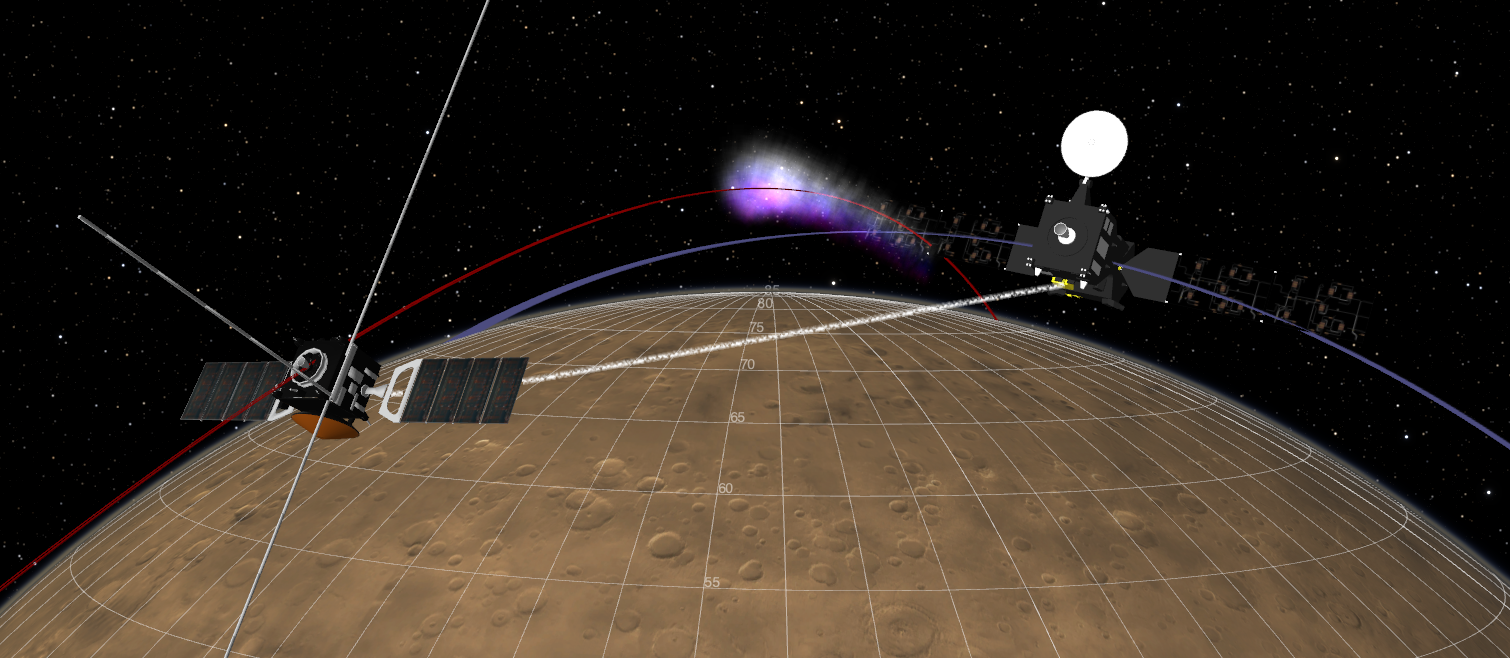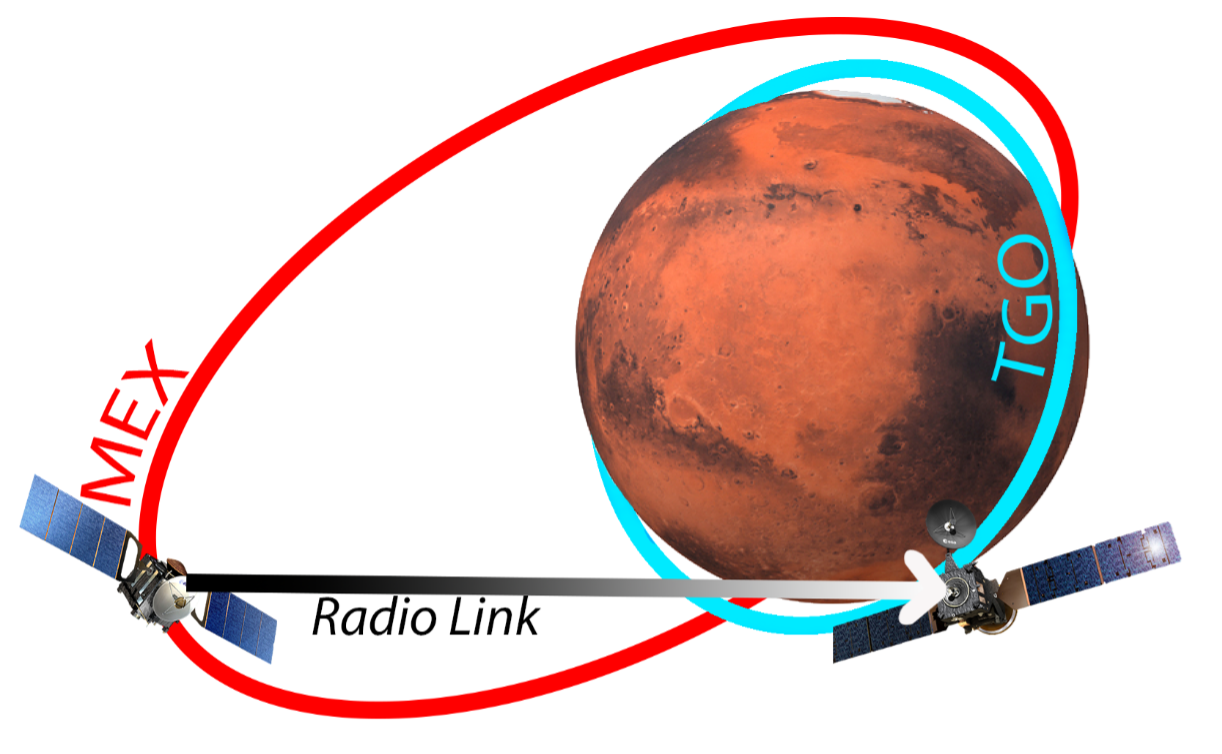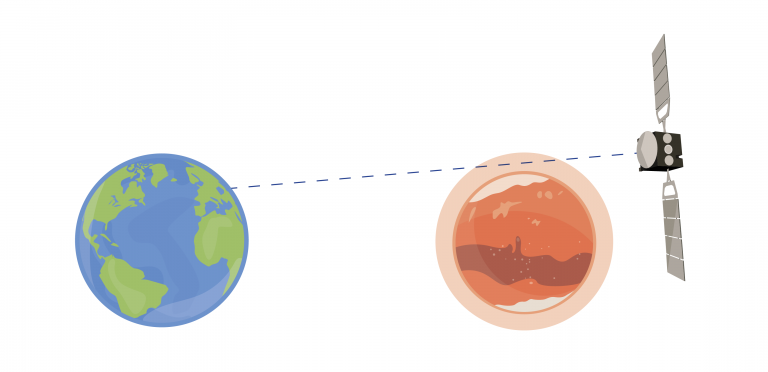By Jacob Parrott, Department of Physics at Imperial College London
We can repurpose equipment for extra science, whilst peering into unexplored features of the martian atmosphere.
Radio occultation is a clever technique to measure atmospheric properties by observing how radio signals bend (refract) as they pass through the atmosphere. This well-established technique has been used for decades, and ESA’s Mars Express orbiter unveiled new layers and views of the martian ionosphere using it.

Martian mutual radio occultation measurement between ESA’s Mars Express (foreground) and Trace Gas Orbiter (background) spacecraft. The magenta trace at the centre of image is the profile of atmosphere probed. The trajectory of Mars Express is shown in red and the blue line is for Trace Gas Orbiter. For visibility, both spacecraft are enlarged by 1000 times. Credits: J. Parrot et al.
This radio occultation is usually conducted using the radio link from the orbiter to Earth. Large ground stations on Earth carefully monitor the radio signal from the orbiter as the spacecraft ‘sets’ behind the planet. This radio signal exhibits tell-tale frequency shifts allowing scientists to reconstruct the properties of the martian atmosphere and ionosphere.
A new approach
For the last couple of years, ESA has been trying something new: they are using a different set of radios, the ones normally designed for short-range communications between orbiters and rovers, for radio occultation.
Signals are broadcast from one ESA orbiter (Mars Express) to another (Trace Gas Orbiter). This approach has the potential to yield a greater number of observations, covering more of the planet, compared to the conventional orbiter-to-Earth occultations. The technique is described in detail in a previous ESA blog post.

Orbital configuration of Mars Express (red) and Trace Gas Orbiter (blue) during a typical mutual radio occultation observation, with a black/white arrow indicating the direction of the radio link between the two spacecraft. Credits: ESA
The first scientific results demonstrating the success of this technique were published in Radio Science on 6 July.
Spacecraft-to-spacecraft radio occultation has become commonplace on Earth, with global navigation satellites relying on radio signals for thousands of daily measurements. These measurements play an increasingly important role in global atmospheric monitoring and weather prediction.
While NASA demonstrated this method on Mars three times as a hardware test in 2007, ESA’s use of spacecraft-to-spacecraft radio occultation represents the first routine application on another planet.
More measurements within reach
Scientists have gathered 142 measurements, including some from previously inaccessible regions of Mars. We are currently gathering roughly one measurement per week.
Why inaccessible regions? Conventional radio occultation measurements for Mars involves a radio link to a ground station on Earth. Because of the Earth-Sun-Mars geometry, conventional radio occultations are limited to sampling near sunset and sunrise. In contrast, spacecraft-to-spacecraft occultation allows to sample locations near local noon or midnight – times inaccessible to conventional radio occultation.

Martian mutual radio occultation measurement between ESA’s Mars Express (bottom) and Trace Gas Orbiter (top) spacecraft. Credits: J. Parrot et al.
Moreover, conventional radio occultation is known to suffer from “occultation seasons,” where these measurements are only available during a small portion of the year due to specific spacecraft orbits. Mars Express, for example, could perform radio occultation measurements for just two months in 2022.

ESA’s Mars Express orbiter performing ‘traditional’ radio science by transmitting
to Earth through the martian atmosphere. Image credit: ESA/S. Poletti
Mutual radio occultation overcomes all these shortcomings. For the first time, we can probe the entire depth of the ionosphere while the Sun is high in the sky, around noon. This is especially interesting because the ionosphere is driven almost entirely by the direct sunlight and is known to block signals if not properly accounted for – a critical consideration for future martian habitation.
This work is also interesting from an engineering perspective. Both the systems on Mars Express and the Trace Gas Orbiter were not initially designed for this purpose. They had to be reprogrammed in orbit to carry out this science, and they were only switched on for around 10 minutes every time an occultation was about to take place.
The scientists and engineers behind this work are looking into how to expand the use of this technique in future Mars missions.
‘First Results of Mars Express – ExoMars Trace Gas Orbiter Mutual Radio Occultation’ by Jacob Parrott et al. is published in Radio Science.

Discussion: no comments